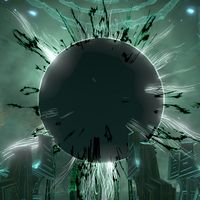Lorkh, who is known as the Spirit of Man, the Mortal Spirit, the Sower of Flesh, and the Lord of Mortals, is the Reachman interpretation[1][2] of Lorkhan, the Creator-Trickster-Tester deity present in some form in every Tamrielic mythic tradition.[3]
Lorkh is a revered spirit in the Reachman pantheon. Their creation story speaks of Lorkh having an epiphany when he visited the darkness; that which is perceived as nothingness is ripe for possibility.[4] And so, Lorkh approached Namira, who ruled the world of spirit, and convinced her to grant him a place in the infinite void to create a realm for wayward spirits, but it was at a cost. To make this a possibility, Lorkh sacrificed himself to create a harsh realm, one that is unforgiving and intended to teach through suffering.[5] Despite his sundering, Lorkh still believed in the light of Man, whose ancestors fled into the mountains, away from the darkness emitted from his heart.[6][7] Hircine is said to have taken the mantle of Lorkh's creation, becoming the sovereign of the world of flesh.[8][1] Despite this, it is believed Lorkh still walks among the mortals of Nirn. He appears only once in a great while, braving the pain and sorrow of the cruel world he created to aid the Reachfolk in times of desperate need.[5]
The briarheart ritual is a reflection of the Reachmen's need to become better, and involves communing with Hircine to ritualistically replace the heart of a skilled Reachfolk warrior with poisoned briars.[9] This ritual represents Lorkh's immortal sacrifice,[5] which is reflected by sacrificing of ones' own life. The end result is a warrior being resurrected[10] as a living weapon with great strength and endurance known as a Briarheart.[11] They endure constant pain,[12] a trade-off to use their transformation's benefit to protect their clan.[11]
The symbol of one of Hircine's aspects, Gulibeg the Quick fox, is the Wand of Bone, which was fashioned from a shard from Lorkh's ribs, and has the ability to confound any mortal.[13] Gulibeg is said to reward those he finds clever by teaching them tricks and secrets,[14] which the Reachmen claim helped them survive the fall of Lorkh.[13]
Lorkh is revered by the Reachfolk, but his name is never uttered in prayer, for his part in their story has long passed. While Hircine teaches the Reachmen how to survive, Lorkh is the reason that "no matter the struggle, (they) should not go quietly into death".[2]
At least some shrines of Lorkh are adorned with the triple spiral symbol of triskelion.[15]
Lorkh also appears in writings that are not primarily related to Reachfolk theology. In The Nine Coruscations by Star-Queen Varalis, he is depicted as battling side by side with Xero-Lyg, a Magna Ge who ventured unto the adjacent space, where they fought within alternate worlds unto endless possibilities. In the same text, there is a mention of the "Indefinite Limits of Lorkh-Apeiron" in connection to the Prime Archon.[16]
GalleryEdit
BooksEdit
- Great Spirits of the Reach: Volume 5 by Vashu gra-Morga, Chief Daedrotheologist at the University of Gwylim — Lorkhan in Reach theology
ReferencesEdit
- ^ a b Great Spirits of the Reach: Volume 3 — Vashu gra-Morga, Chief Daedrotheologist at the University of Gwylim
- ^ a b Ardanir's dialogue in ESO
- ^ The Monomyth
- ^ The Dark Descent's loading screen in ESO: Markarth
- ^ a b c Great Spirits of the Reach: Volume 5 — Vashu gra-Morga, Chief Daedrotheologist at the University of Gwylim
- ^ Nchuand-Zel's loading screen in ESO
- ^ Lost Valley Redoubt's loading screen in ESO
- ^ Letter to Apprentice Gwerina — High Shaman Glynroch
- ^ The Improved Emperor's Guide to Tamriel: Northern Bangkorai and the Mountains — Flaccus Terentius, 2E 581
- ^ Faorin's dialogue in ESO
- ^ a b Medone's dialogue in ESO
- ^ Kyrtos' dialogue in ESO
- ^ a b High Shaman Glynroch's dialogue in ESO
- ^ Aspects of Lord Hircine — Juno Procillus, Academy of Chorrol
- ^ Appearance of the Shrine of Lorkh during The Lost Shrine in ESO: Markarth
- ^ The Nine Coruscations — Star-Queen Varalias
